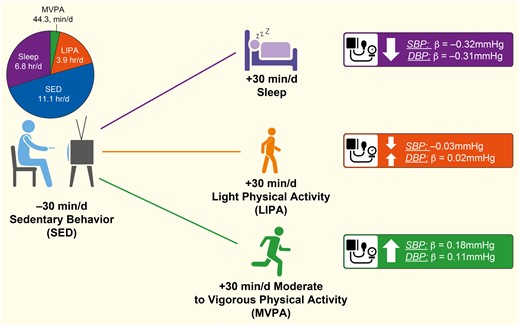-
Views
-
Cite
Cite
Benjamin D Boudreaux, Joseph E Schwartz, Emily K Romero, Keith M Diaz, Reallocations of Time Between Sleep, Sedentary Behavior, and Physical Activity and Their Associations With 24-Hour Blood Pressure, American Journal of Hypertension, Volume 38, Issue 3, March 2025, Pages 164–167, https://doi.org/10.1093/ajh/hpae149
Close - Share Icon Share
Abstract
The 24-h activity cycle (24H-ACT) (sleep, sedentary behavior, light physical activity, and moderate to vigorous physical activity) may have deleterious or beneficial associations with 24-h blood pressure (24H-BP).
Estimate the short-term associated changes in 24H-BP with acutely replacing 30 min/d from one behavior of the 24H-ACT to other behaviors in employed adults.
Participants (N = 659) wore an ambulatory blood pressure monitor and two accelerometers (waist and wrist) to measure 24H-BP and the 24H-ACT.
Replacing 30 min of sedentary behavior with 30 min of sleep was associated with lower 24-h mean systolic [ß = −0.32 mm Hg per 0.5 h (95% CI: −0.58, 0.06)] and diastolic [ß = −0.31 mm Hg per 0.5 h (95% CI: −0.50, −0.12)] blood pressure. Replacing 30 min of light physical activity with 30 min of sleep was associated with lower 24-h mean systolic [ß = −0.30 mm Hg per 0.5 h (95% CI: −0.62, 0.03,)] and diastolic blood pressure [ß = −0.34 mm Hg per 0.5 h (95% CI: −0.58, −0.11)]. No other time reallocations between 24H-ACT behaviors were associated with changes in 24H-BP.
Replacing time in sedentary behavior or light physical activity with sleep may provide small short-term reductions in that day’s 24H-BP.





